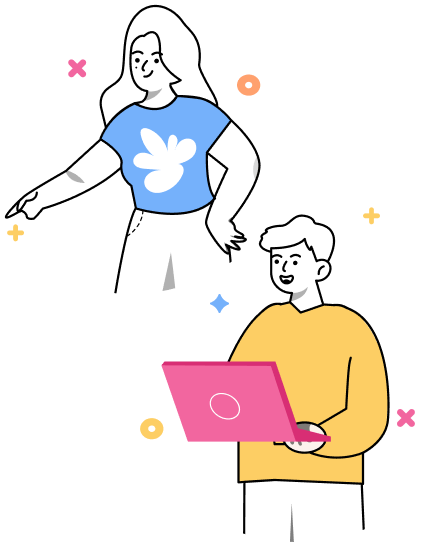36 Employee Engagement Ideas to Boost Team Connection
Discover 36 employee engagement ideas that work, including team-building activities, participatory meetings, icebreakers, fun games, and recognition programs.

When your team avoids collaborating, contributes less in meetings, or just does the bare minimum, it’s a sign of disengagement.
Employee engagement is the degree to which someone feels mentally focused, emotionally invested, and socially connected to their daily work. When engagement is high, teams communicate better, take initiative, and stay aligned with company goals.
Many leaders mistake engagement for commitment or loyalty. But an employee can be loyal to the company and still feel disconnected from their role.
Understanding the different levels of engagement within your team is key to addressing these issues effectively. Each level, whether engaged, not engaged, or disengaged, shows up in different ways and requires a tailored response.
Here’s a quick overview:
1. Lead by Example
Employee engagement starts with good leadership habits. According to a study, servant leadership, where leaders prioritize ethics, shared power, and recognition, has the strongest positive impact on employee engagement. When leaders model accountability and give credit to others, they give people the confidence to fully commit.
For example, when a manager owns a project delay and explains how they’ll adjust the plan, it builds trust and encourages accountability. These small actions create a culture where people feel safe to speak up. When leaders are engaged, teams are more likely to follow.
💡Action steps:
In your team meetings, call out one specific moment where someone’s input changed your approach or decision. You can also use Slides With Friends to hold Employee Appreciation Day. Every team member can vote on live polls to choose the best employee of the month/week.
2. Build Psychological Safety
Psychological safety is a precondition for engagement. You should prioritize creating safe environments that encourage employees to take risks without fear of judgment or backlash. This gives your employees ownership and promotes confident idea-sharing, especially among Gen Z workers.
💡Action steps:
You can build a safe working environment by responding calmly to tough feedback, inviting input in meetings, and recognizing effort rather than just outcomes.
For example, if a team member shares a concern during a planning meeting, listen without interrupting. Thank them for speaking up and follow up on their idea later. This shows that honest input is welcome and taken seriously.
3. Create Clear Communication Loops
Engagement drops when employees feel left out of key updates or unclear about decisions. Use transparent communication channels to help them understand the “why” behind changes and how their workflow fits in.
You can build this loop by regularly sharing progress on team goals, explaining leadership decisions, and inviting questions in open forums. When employees see how their input shapes outcomes, they stay more connected and invested.
💡Action steps:
Use Slides With Friends to run real-time Q&A polls or collect anonymous feedback slides during your team meeting. Your employees can respond via their phones, allowing you to surface confusion early, clarify priorities, and close the loop. This helps you make communication a two-way experience.
4. Crowdsource Ideas in a Safe, Fun Way
Traditional brainstorming workshops only favor the loudest voices or the most senior team members. Create a space for employees where they can contribute without fear of judgment or hierarchy.
Anonymous crowdsourcing is one of the most effective ways to boost engagement, especially when it feels fun, low-stakes, and interactive.
💡Action steps:
Use Slides With Friends’ word cloud feature to collect anonymous input on a focused question. Let your team submit their answers live and display the word cloud on the screen as responses roll in. Then, open the floor for group voting or discussion.
Turn the most common or surprising ideas into action items. When employees see their input being used, it builds trust and increases future participation.
5. Recognize Effort, Not Just Outcomes
A report found that 90% of employees say recognition motivates them to work harder, and those recognized monthly or more are 2.7× more likely to be highly engaged.
Acknowledge process-oriented behaviors, like persistence, learning, helping others, or demonstrating company values. This contributes to a stronger sense of fairness, belonging, and motivation.
💡Action steps:
Make recognition immediate, visible, and focused on behaviors you want to reinforce. Use team-building decks on Slides With Friends to recognize and celebrate effort together, whether it’s through anonymous shoutouts, peer nominations, or shared wins.
6. Coach Instead of Micromanaging
Micromanagement makes people feel watched all the time. It lowers employee morale and breaks their creativity.
Coaching is different. It helps employees feel trusted, supported, and confident. They understand their role better and feel more in control of their work. That makes them care more, work harder, and stay longer.
💡Action steps:
Replace directive check-ins (“Did you finish it?”) with open coaching questions using the GROW framework:
- Goal: “What are you aiming for?”
- Reality: “What’s working or not?”
- Options: “What else could you try?”
- Will: “What’s your next step?”
This helps employees think critically and take ownership, instead of just reporting status.
7. Do Icebreakers Before Team Meetings
Icebreakers help people feel more comfortable and accepted, which opens space for participation. A study shows that icebreakers help reduce tension and improve focus, especially in virtual learning environments.
💡Action steps:
Play an icebreaker game using Slides With Friends to kick off your meeting. Team members can join in and share answers anonymously or by name. Seeing live responses helps everyone feel included, which makes people more likely to speak up and engage.
8. Host Leader-Led Feedback Roundtables
Run regular leader-led roundtables to gather honest feedback and show employees that their input drives change.
Real-time dialogue with leadership builds trust, boosts engagement, and increases follow-through on goals.
💡Action steps:
Use Slides With Friends to run a quick SWOT brainstorming session. Ask prompts like “What’s one internal strength we should double down on?” or “What external challenge do you see coming?” Let employees submit answers anonymously, vote on priorities, and discuss solutions together. Check out our SWOT analysis template.
9. Use Team Trivia to Build Fun, Inclusive Connection
Host quick trivia games with lighthearted questions about teammates, company culture, or shared interests. This sparks laughter, builds a sense of belonging, and strengthens team identity.
💡Action steps:
Use Slides With Friends to host a team-building trivia game that includes a mix of fun questions and company-related facts to keep things inclusive. You can also rotate who creates or hosts the trivia so everyone gets a chance to lead and participate.
10. Set up Listening Programs
Host regular listening programs, like skip-level meetings, pulse surveys, and feedback roundtables. This allows employees to voice concerns and co-create solutions directly with leaders.
Lincoln Financial introduced a structured employee listening strategy to strengthen culture and belonging. Through regular company-wide surveys, focus groups, one-on-one meetings, and follow-up action plans, they gave employees space to speak openly and be heard. As a result, 76% of their workforce reported confidence in their professional growth prospects.
💡Action steps:
- Run monthly pulse surveys with just 3–5 questions to quickly check how employees feel about communication, leadership, and workload.
- Host skip-level meetings where senior leaders connect directly with junior staff to address any minor challenges and build trust.
11. Hold ‘Get to Know You’ Activities to Build Team Understanding
When people know who they work with, they collaborate better and feel more comfortable speaking up. Quick games like “Two Truths and a Lie” or “Guess Who?” help teammates learn fun facts about each other and find common ground, especially helpful in remote or cross-functional teams.
💡Action steps:
Hold a “Get to Know the Group” activity and use Slides With Friends for engagement. Ask quick team-building questions or invite employees to share the highlights of their weekend using image prompts. This builds a connection and makes every employee feel inclusive.
12. Let Teams Define Their Own Success Metrics
When teams define their success metrics, they feel more in control of their work. When employees participate in goal setting, they feel more invested, trusted, and motivated to perform at their best.
Rather than following top-down KPIs, teams become co-creators of their outcomes, making the work feel more meaningful.
13. Let Teams Set Their Own Norms and Decision Rules
Let teams decide how they want to work together, like when to meet, how to give feedback, and how to make group decisions. This builds trust, ownership, and cohesion without top-down pressure.
According to Deloitte’s 2025 Gen Z and Millennial Survey, 87% of Gen Zs who feel trusted by their employer say they’re likely to stay at least five years.
💡Action steps:
Rotate a monthly norm steward whose role is to spot when norms are unintentionally broken (e.g., meeting interruptions, unclear feedback) and gently remind the team. This maintains social agreement without manager intervention.
14. Involve Employees in Process Redesign or Tool Selection
When employees choose the tools or workflows they’ll use every day, they feel more in control of their success. This strengthens commitment and leads to smoother adoption of new systems.
💡Action steps:
Run an interactive employee training session when launching a new tool or process. Use live polls or open-response questions to gather real-time feedback. This helps you learn how well the tool fits into daily workflows and shows employees that their input matters.
15. Host Monthly Team Lunches With Open Conversation Themes
Monthly team lunches can build connections, especially when people from different roles or departments join. Pick a casual theme each time to spark storytelling and shared insight, like “A failure I learned from,” “My first job ever,” or “A time I solved a tough work challenge.”
💡Action steps:
If you’re a remote team, schedule the session at a rotating time each month to accommodate different time zones. Let teams opt into regional breakout rooms for more comfortable participation.
You can host a mindful lunch using Slides With Friends for a fun game to engage employees during the lunch break.
16. Share Budgets and Let Teams Plan Their Own Offsites or Training
Let teams plan their offsites or training. Instead of top-down planning, give each team a set budget and broad guidelines. Ask them to pitch how their idea supports team goals or OKRs.
Give each team a quarterly budget and a clear strategic theme, like "collaboration" or "well-being." Ask them to co-design an off-site learning experience or shared activity that reflects that theme.
17. Make Onboarding Collaborative, Not Passive
New hires feel more engaged when they’re invited to interact, contribute, and connect from day one. Instead of handing over manuals, give them opportunities through mentorship, peer interaction, and hands-on tasks.
This improves their engagement, reduces uncertainty, and boosts early connection to the team and purpose.
💡Action steps:
Hold a scavenger hunt using Slides With Friends before the onboarding session as a fun team-building activity. It’s a fun way to get new hires to engage, meet new people, and learn about your company.
18. Run Interactive Workshops on Team-Created Topics
Let your team choose what they want to learn. Collect topic ideas, vote on the most useful ones, and invite team members to lead or co-create the sessions. This builds ownership and keeps learning practical and relevant.
💡Action steps:
Use Slides With Friends to collect topic ideas through a live word cloud. Then, hold a live poll based on the top six topic ideas from the word cloud. Let employees upvote their favorite topic and show instant results on the screen. Once you have your topic, let two or three volunteers co-create the session with you.
19. Make Reviews and Meetings Participatory
At the end of a project, like a product launch or website redesign, teams hold a review meeting to help teams reflect on what worked and what didn’t. But managers do most of the talking, while team members are asked to respond one by one.
Instead, turn your review meetings into interactive discussions. Use anonymous Q&As, live polls, and word clouds to invite input from everyone at once. These tools help you address real insights, especially from team members who may hesitate to speak up.
20. Let Employees Upvote Internal Improvement Ideas
Create an internal space where employees suggest and upvote ideas to improve tools, workflows, or processes. The more votes an idea gets, the more important it becomes to fix. This helps leaders see which problems matter most to the team.
21. Run Employee Recognition Programs
People feel more motivated when their work is noticed. A simple “thank you” or public shoutout can make a big difference in how connected and valued someone feels.
Build a regular recognition program where team members can nominate each other. You can highlight wins in a team meeting, in a group chat, or through a monthly award.
For example, Cisco runs a “Connected Recognition” program where employees send e-cards and awards to teammates globally. It helped boost engagement and build strong peer connections.
💡Action steps:
Let employees choose the categories, like “Most Helpful Teammate” or “Best Problem Solver.” This makes the program feel personal and fun, not forced.
22. Offer “Cushy Job” Freedom Instead of Hustle Culture
According to a Deloitte study, only 6% of Gen Zs say their top career goal is to reach a leadership role, while 70% are actively building new skills weekly, outside work hours. Most employees crave jobs that allow them to grow at their own pace.
Instead of pushing the hustle mindset, offer flexibility in how work gets done. This gives employees time to recharge, pursue skill-building, and return with more energy for long-term engagement and retention.
💡Action steps:
- You can assign no-meeting days or partial meeting bans, especially after intense deadlines.
- Let high performers set their own focus hours and evaluate them based on results.
23. Offer Internal Career Pathing Maps with Clear Upskilling Goals
Employees engage more when they see a future for themselves in the organization. A clear path helps them understand how to grow, what skills to build, and where their current role can lead. This gives day-to-day tasks more meaning and keeps development tied to long-term goals.
💡Action steps:
Create visual role progression maps with required skills, courses, and mentoring checkpoints. Use quarterly check-ins to update goals. Let managers co-create development plans aligned to real business needs.
24. Let Employees Pitch New Initiatives
Top performers often outgrow their job descriptions. Give them space to propose new roles, projects, or workflows. This builds trust and motivates employees to work harder.
💡Action steps:
Set up a quarterly “innovation pitch” slot during all-hands meetings for engagement. Offer support from a mentor or cross-functional lead to help shape proposals. Then, reward successful pilots with time or budget.
25. Encourage Employee Storytelling
Employee storytelling is an effective way to recognize effort internally. Encourage team members to share short, real stories of how someone helped, solved a problem, or lived company values. This humanizes recognition and builds an emotional connection.
💡Action steps:
At every town hall, spotlight 3–5 employees' stories and invite the recognized employee to share a “behind‑the‑kudos” detail in their own words.
26. Fund One Learning Goal per Employee Each Quarter
Give every employee the chance to pick one skill they want to build, then back it with a learning budget each quarter. This shows that you support their career growth. It also helps prevent burnout and boosts motivation.
💡Action steps:
Set a standing calendar invite every 90 days where each person shares their learning goal with their manager and picks a resource to pursue a course or event.
27. Celebrate Internal Promotions Publicly
Announce promotions across team meetings, newsletters, or Slack to reinforce a culture of internal growth. When people see peers advancing, they’re more likely to stay invested and envision a future within the company. Recognizing upward moves keeps ambition and morale high.
28. Host Hackathon-Style Innovation Sprints
Run short events where employees team up to solve a real business problem, improve a workflow, or pitch a bold new idea. These sprints encourage creativity, quick action, and team bonding, especially across roles.
For example, Pinterest holds a Makeathon every year to invite all employees to anonymously pitch ideas. They form cross-functional teams to bring those ideas to life in a 3-day sprint. Since ideas are submitted anonymously and teams are supported by expert “Hack Doctors,” employees feel safe sharing honest feedback and ambitious ideas.
In 2024 alone, Makeathon produced over 198 ideas and 85 working prototypes, many of which were adopted across the company.
29. Turn Farewells Into Celebrations of Contribution
When employees leave, host a short farewell session where peers share one thing they appreciated about the person’s work.
A thoughtful farewell reinforces belonging and shows others that their time will be valued too. Celebrate contributions through stories, shared memories, or small tokens. This helps preserve your team’s emotional connection.
💡Action steps:
Use Slides With Friends to make the farewell session more engaging and interactive. Our platform lets your employees participate, send emoji reactions, and share stories about the employee. Check out our Farewell Coworker Appreciation template.
30. Start a “Problem Solvers Wall”
Highlight creative fixes, cost-saving ideas, or workflow hacks on a shared digital wall or office space. You or your team can nominate one creative solution monthly. Include what problem was solved, who led it, and what others can learn from it.
Recognizing critical thinking reinforces autonomy and encourages others to speak up with ideas.
31. Break Down Silos with Fun Team Challenges
Create friendly competitions where cross-functional teams solve a fun task. These activities build social ties and improve interdepartmental understanding without the pressure of formal collaboration.
💡Action steps:
Give each team a real internal challenge to solve creatively, like improving an onboarding step or redesigning a meeting format. Offer small prizes and present winning ideas at the next all-hands meetings to show their impact.
32. Host a Fun-Themed Virtual Happy Hour
Hold monthly themed parties or relaxed end-of-week hangouts to improve hybrid or remote employee engagement.
Casual bonding strengthens trust, improves communication, and helps employees see each other as more than just job titles. It’s a low-pressure way to recharge socially and maintain engagement outside formal tasks.
💡Action steps:
You can host monthly themed trivia games on Slides With Friends. For example, you can hold a Cocktail Convos, where everyone can participate in fun cocktail quizzes, share drink opinions, or vote on their favorite bar!
33. Give Team Awards for Customer Impact, Not Just Output
Recognize teams whose work improved customer outcomes, whether it's fewer complaints, better onboarding, or positive feedback. This reinforces a sense of mission and makes everyday work feel more meaningful.
💡Action steps:
Add a “Customer Kudos” segment to team meetings. Include short stories, quotes, or metrics that show how internal work made a difference externally.
You can also ask your employees to vote on who did well. Use Slides With Friends to hold a quick live poll on nominated team members, while others vote. Our platform will instantly display results so everyone can celebrate the achievement together.
34. Gamify Employee Training
Traditional training sessions can feel long and forgettable. Gamification makes learning active, social, and stickier. Employees stay engaged when they’re earning points, solving puzzles, or working through levels.
You need the right employee training tools and methods to reinforce learning.
💡Action steps:
You can create small games within your training module. Use Slides With Friends to create interactive slides to engage your audience.. Add a quick quiz after a long module, or a word cloud to hear your employees’ opinions on a certain topic.
35. Publish a Monthly “Win + Learn” Digest
Instead of formal reports, send a monthly internal email or newsletter that shares one “win” and one “lesson learned” from different teams. This builds a culture of transparency and shared learning without judgment.
It also gives quiet teams or individuals a way to get noticed for smart thinking or thoughtful reflection, even if they’re not on center stage.
💡Action steps:
Don’t just focus on workplace-related achievements. You can highlight volunteer work, moments of kindness between departments, or even a failed idea that led to a better solution.
36. Hold Back-to-Office Events After Long Holidays
Returning after a long break, like Easter holidays, Thanksgiving, or year-end, can leave employees feeling sluggish or disconnected. A simple, thoughtful welcome back helps them reintegrate with confidence and feel remembered.
Host a 30-minute back-to-office ritual, like a quick “what’s new” roundtable, or let the returning employee share highlights from their time away.
💡How to do it better:
Use our back-to-office icebreaker on Slides With Friends to save time and effort. Play a quick game like “What I Did Over the Break” using image prompts or polls. Let everyone share small wins, travel moments, or favorite meals to spark conversations and re-engage the team.
Benefits of Employee Engagement
Here are some benefits of employee engagement offers for leaders, trainers, and business owners:
Increases Individual and Team Productivity
Engaged employees focus more, need less supervision, and complete work faster. Teams with high engagement often hit deadlines earlier and take initiative without being asked.
Improves Employee Retention and Reduces Turnover Costs
When people feel connected to their work and career path, they’re less likely to leave. This reduces the high cost of rehiring and retraining, especially in growing teams.
Boosts Overall Company Profitability
A Gallup study found that companies with highly engaged teams earn 23% more profit than those with low engagement. Employee engagement makes people stay longer, grow within the company, and contribute more value over time.
Encourages Better Team Collaboration
Engaged employees are more likely to support colleagues, share resources, and resolve conflicts constructively. This leads to smoother workflows, improved team alignment, and fewer project delays.
Lower Rates of Absenteeism and Unplanned Leave
Disengaged employees tend to avoid critical work or depend on the leader to do it. Employee engagement initiatives motivate employees to show up and put in effort because they see their role as meaningful and their presence as valued.
Strengthens Company Culture and Morale
Teams that feel heard, supported, and celebrated contribute to a more positive culture. For example, hosting a quick virtual coffee break can help reinforce those everyday moments of connection.
Builds Resilience During Change or Disruption
Engaged employees adapt easily when priorities shift. They’re more likely to trust leadership, work on team building, stay committed through uncertainty, and help others stay focused.
How Slides With Friends Help You Increase Employee Engagement

Slides With Friends is a presentation tool for HR teams, managers, trainers, and team leads who want to engage, communicate, and connect with their employees.
Our platform offers interactive elements and engagement tools that help you turn your boring meetings into memorable experiences.
Here’s how Slides With Friends helps you improve employee engagement:
Interactive Elements With Real-time Feedback

Using traditional slides in team meetings makes them feel one-sided and boring. Slides With Friends gives you interactive tools to engage your employees without much effort.
Whether your team is remote, hybrid, or in the office, you can:
- Launch live polls to gather instant opinions and mood checks
- Host quizzes and assessments to reinforce key topics or values
- Run word clouds and brainstorming slides to surface ideas, sentiment, and priorities
- Allow Q&A and upvoting so every voice gets heard and validated
- Use ratings with preset scales, like 1–10, emoji, or Likert formats, to measure feedback, satisfaction, or agreement on key topics.
This makes every session feel like a two-way conversation, keeps the energy up, and allows quieter team members to participate easily.
Gamify Your Meetings, Workshops, and Activities to Increase Engagement

Adding gamified elements to your everyday meetings and workshops turns passive listeners into active participants.
Slides With Friends offers audience engagement tools, like emoji reactions, soundboard, avatars, and username with a live scoring leaderboard. You can create a game using our trivia builder or use one of our templates and edit them to your preferences.
The game trivia makes it easy for you to gamify your content to engage your audience in a fun way. Instead of reading out your traditional module, break it into digestible bits with interactive elements to make learning and team building memorable.

Once your game is ready, simply share your screen and start the Event. The audience can scan the QR code displayed on the screen to join, set an avatar, and type a username to begin.
Gamification activates attention and reinforces memory, making your sessions more productive and fun. It’s also the best way to engage Gen Z and millennial employees who like interactive, social settings.
Easy Creation and Actionable Insights
Slides With Friends makes it easy to run interactive meetings, training, or team-building events, without wasting hours on formatting or slide design.
Choose a deck from our 100+ template library. Personalize them using the drag-and-drop builder, preview how everything looks on mobile, and launch directly from your browser.
If you already have slides on with PowerPoint and Google Slides, Slides With Friends lets you import your content and layer in engagement elements, like polls or reactions, to make it participatory.
The platform also works with video conferencing tools like Zoom and Microsoft Teams. Simply share your screen to run your interactive deck live during virtual meetings or hybrid sessions.

Once your session ends, you’ll get slide-by-slide analytics showing real-time employee engagement, responses, and poll results. You can see this data to adjust your approach and plan more impactful future sessions.
Sign up to learn how Slides With Friends helps you increase employee engagement and productivity.


Ready to ditch the dull, and run team sessions that people will actually enjoy?
Get started with a Slides with Friends deck in no time. We’ve got all the interactive features you need in one easy-to-learn, easy-to-set-up tool.















